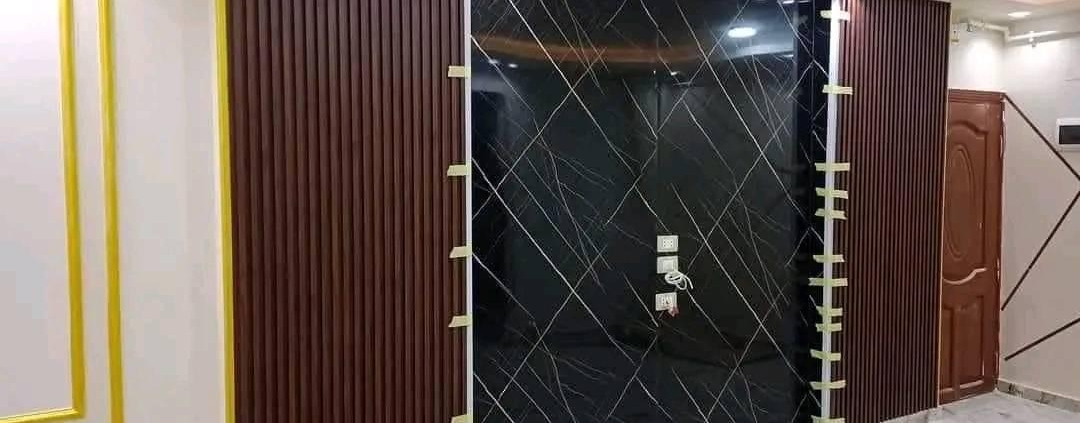Wood and marble alternative works in Saudi Arabia
Saudi Arabia has always been a pioneer in adopting the latest trends in decoration and finishing. In recent years, wood and marble alternatives have seen a tremendous boom, becoming a primary choice for decorating and cladding walls, floors, and facades in homes and commercial projects alike.
There are numerous companies and factories in Saudi Arabia specializing in wood and marble alternatives, offering these materials in the form of panels or decorative sections for home and store entrances and interior design. Marble and wood alternatives vary based on the manufacturing material, such as PVC, acrylic, and MDF. Their prices vary and are suitable for specific uses depending on requirements.
Wood and Marble Alternatives in Saudi Arabia: Innovation Meets Luxury
The trend toward the use of natural material alternatives in Saudi Arabia is a response to several factors, most notably the need for economical, practical solutions that are resistant to harsh climatic conditions (heat and humidity), without sacrificing a luxurious aesthetic appearance.
First: Wood Substitute
Wood substitute is a decorative panel often made from PVC (polyvinyl chloride) or WPC (wood-plastic composite), environmentally friendly materials that mimic the appearance of natural wood in its finest details.
1. Advantages of wood substitute:
Highly resistant to weather conditions: It is unaffected by moisture or water, and is not susceptible to corrosion or the growth of fungi and insects (such as termites), making it ideal for humid areas and even for outdoor use.
Lightweight and easy to install: It can be quickly and easily installed using special adhesives or nails, and allows for flexibility in cutting and shaping.
Easy maintenance and cleaning: It can be wiped and cleaned with water and ordinary materials without worrying about damage.
Variety of shapes and colors: It is available in multiple designs, such as ribbed or flat panels, and in colors and patterns that mimic various types of wood.
2. Its most prominent uses in Saudi décor:
Interior wall decoration: It is used to cover an entire wall or to create modern frames and panels for living rooms and halls.
TV screen wallpapers: This is the best choice for designing elegant TV screens integrated with hidden lighting.
Suspended ceilings and entrances: To add warmth and a natural feel to entrances and foyers.
Exterior facades: (In the case of WPC panels) due to their high resistance to sun and heat, they are used to clad the facades of villas and buildings.
Second: Marble Substitute
Marble substitutes are decorative panels, often PVC or acrylic, printed with marble patterns using high-quality technologies, such as UV panels or quartz panels (for countertops), to mimic the luxurious appearance of natural marble at a much lower cost.
1. Advantages of Marble Substitutes:
Aesthetic Appearance: Accurately mimics the beauty and veining of natural marble in a variety of colors and patterns (such as white with gold veins or black with white veins).
Excellent Resistance: Water, stain, and heat resistant, making them practical for kitchens and bathrooms.
Light weight: Much lighter than natural marble, making transportation and installation easier and reducing stress on structural elements.
Easy installation and maintenance: It is fixed using special adhesives (such as silicone), is easy to clean, and does not require periodic polishing.
Economic cost: It is much cheaper than natural marble and granite.
2. Its most prominent uses in Saudi décor:
Bathroom and kitchen wall cladding: Due to its high resistance to moisture and water.
Sink countertops: For a quick and elegant decoration behind guest sinks.
Open book decorative panels: Used to create illuminated wall art that showcases the beauty of marble veining.
Countertops: Quartz is used as an alternative to marble in kitchen countertops due to its superior scratch and heat resistance.
Installation and Implementation Companies in the Saudi Market
Companies and institutions specializing in the supply and installation of these alternatives are widespread in major cities (Riyadh, Jeddah, Dammam, and Khamis Mushait). They typically offer:
Design Consulting: To help clients choose the appropriate colors and patterns.
Skilled Technicians: Specializing in precise cutting and professional installation to ensure consistency and seamless integration of panels (especially marble alternative panels).
Decorative Integration: Combining wood and marble alternatives with other decorative materials such as foam, lighting, and mirrors to create a complete and modern design.
Overall, wood and marble alternatives in Saudi Arabia are a modern and smart choice, balancing the need for luxurious aesthetics with practicality and economic necessity in the growing construction and decoration sector.
Types of Marble and Wood Alternatives:
Marble Alternatives:
There are various types, such as panels made of lightweight materials in various designs and shapes suitable for walls, ceilings, and shops.
Wood Alternatives:
These include materials such as PVC, MDF, and acrylic, which are characterized by their resistance to moisture and water, and are easy to shape and install.
Uses of Marble and Wood Alternatives:
Interior Decoration:
They are used to decorate homes and shops, especially in entrances and wall facades.
Various Applications:
PVC benefits from its high water resistance, making it ideal for kitchens and bathrooms.
Characteristics of Marble and Wood Alternatives:
Aesthetics and Versatility:
These materials are available in a variety of designs and colors to suit different tastes.
Durability and Weather Resistance:
Some materials, such as PVC, are highly resistant to water and moisture.
Ease of Use:
They are flexible, easy to install, and easy to clean, making maintenance easier.
Specialized Exhibitions:
Wood and marble alternative products are displayed at exhibitions specializing in decoration and interior design.
Selection Advice:
The best choice depends on the requirements of your decoration project, taking into account durability, aesthetics, cost, and ease of use.




